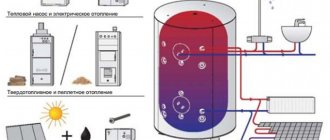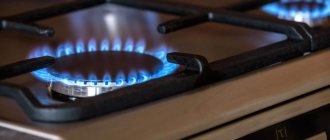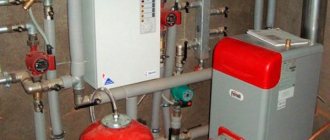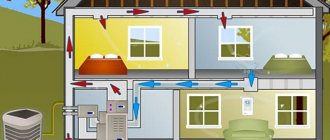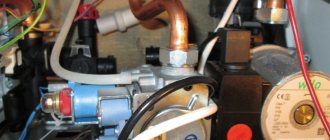Unfortunately, tariffs are only getting higher every day. Therefore, saving gas is not only a pressing issue, but also necessary for maintaining the family budget. There are a sufficient number of ways to save natural resources.
Choosing ways to save gas is necessary not only for the rational use of money. This should also be done in order to preserve the ecological system on the globe. In European countries, people save gas precisely because they treat natural gifts sparingly and with care. The issue of price, of course, is also of interest to them, but the protection of nature is in the foreground.
In general, you should figure out what devices for saving gas will help save your budget, as well as the environment. Everyone chooses their own, but in order to bet on a certain option, you should study in detail the advantages and disadvantages of each invention.

How to save gas Useful tips
Obviously, if gas consumption meters are not installed in the apartment, then saving gas makes no sense.
In the past, when gas cost a penny, and no one even thought about metering devices, with poor centralized heating, they heated the living space using a gas stove. Today everything has changed. Gas costs money, and its value is constantly growing. In order to pay not at the general tariff, but only for what is consumed, many install gas meters. Then they immediately start saving. In this life hack we will tell you how to save gas in an apartment with a meter.
How to save gas when cooking
Here are some tips on how to save gas when cooking. By following them, you can reduce your stove's gas consumption by 30%.
Use the correct cooking utensils
Throw away all your old pans. They were created for use in an era when gas was plentiful and cheap. Buy 1-2 pots with energy-saving properties. We don’t know exactly how manufacturers achieve this effect, but these pans have amazing properties:
they actually require less gas while maintaining high efficiency
the contents of such a pan boil faster
To maintain boiling at the desired level, the minimum heat is required
Yes, energy-saving pans are more expensive than regular ones. But since this is a long-term item, sooner or later it will pay for itself, and you will start saving gas immediately. In addition, new and modern kitchen utensils are always pleasant and joyful.
Reduce cooking time
Practice shows that people traditionally unjustifiably increase the cooking time on the stove. This is especially true for vegetable dishes. You can often see in recipes and recommendations that, for example, celery root needs to be cooked until tender for 15-20 minutes. Although in reality 5 minutes is enough.
Accustom yourself to the fact that the less you cook vegetables, the healthier and tastier the dish will be. For example, to cook broccoli you need no more than 5 minutes in boiling water. Despite this, many people can cook broccoli soup for 30 minutes.
You can't do it with meat in five minutes. But even in this case, the cooking time can be reduced. To do this, cut the meat into small pieces. For example, a large piece of beef needs to be cooked for 1.5-2 hours. By forming small pieces, you will reduce the time to 30-40 minutes.
Some foods do not need to be boiled
Do you know what our great-great-grandmothers did with buckwheat porridge in the days when they cooked in ovens? They poured water over the cereal, brought it to a boil, after which they tightly “wrapped” the pan or cast iron with a blanket and left it for 1 hour.
Within an hour, the porridge absorbed all the water and became boiled and tasty. Result: instead of 30 minutes of cooking, bring to a boil for 10 minutes. Yes, it will take more time for the porridge to “arrive”, but if you are not in a hurry, then the gas savings are obvious.
This strategy works not only with buckwheat, but also with all other cereals, porridges, and vegetables.
Maintain an average level of gas supply to the burners
We often do not know what to do, including when we use a gas stove. Most of us, out of habit, open the gas burner to full power. Paradoxically, this approach not only does not speed up heating, but in many cases reduces the efficiency of a gas stove and increases costs.
The fact is that the maximum flame temperature is reached at its periphery. When we turn on the gas too much, the flames seem to “grasp” the bottom of the pan, or at least fall almost along the diameter of the bottom. This leads to the fact that part of the energy goes bypassing the dishes and is dissipated. As a result, we spend more gas than required.
Individual heating of water for domestic use is not a bad idea in the age of centralized hot water supply. In this case, you pay only for the volume of heated water that you used; you do not heat the air and ground around heating mains, basements and reinforced concrete floors with this heat. Unfortunately, there are only two options to save gas by using a gas water heater.
You should install a water heater that turns on the gas supply (and, accordingly, heats the water) only when it is in use. Such devices are equipped with electric ignition, which is activated as soon as water begins to flow through the unit. Compared to non-flowing columns, such devices can save up to 50% of gas.
Fuel saving devices
There are several options for appliances: Gas Saver, thermostats and condensing boilers.
Gas Saver
It is better to purchase Gas Saver immediately with the purchase of a thermostat. It is a device based on a magnet. It is installed at the base of the pipe where the hose is screwed on.
The principle of operation is that gas molecules passing through the pipe are broken up under the influence of a magnetic field into an ordered structure. In this form, gas is consumed most efficiently.
The device helps save up to 30% fuel.
In addition, the advantages of Gas Saver include:
- no need to monitor the operation of the device;
- its small size will not spoil the interior; in extreme cases, it can be easily decorated;
- installation does not require special skills or experience;
- It's inexpensive.
Among the disadvantages are:
- inability to customize the device to suit your needs;
- the correctness of the installation and the results of the work will be noticeable only by the figures in the utility bills.
Important!
Homemade magnetic devices can damage gas meters.
Thermostats

Photo OZON The thermostat is a programmable device for saving gas. Its task is to turn off and turn on the boiler when a threshold temperature value is reached. That is, as soon as the air in the room cools down to the user-programmed value, the thermostat turns on the boiler. On the contrary, when the room temperature becomes higher than the specified one, the device turns off the boiler.
Helps save up to 20% of consumed heat. The advantages also include:
- maintaining a comfortable temperature without constant monitoring of the boiler;
- quick payback for the device - in two months the device will recoup its price;
- eliminates the disorder of the boiler's on-off cycles, thereby extending its service life;
- There are different types of thermostats for specific needs and capabilities.
Attention!
If the room doesn't retain heat well, a thermostat won't be very effective. It works well only in combination with other gas saving measures.
The disadvantages of a thermostat include:
- the device requires careful handling, since its sensors can easily be damaged;
- each room requires its own thermostat, and the doors between these rooms must be closed so that the temperature does not equalize;
- requires the correct installation location.
Condensing boilers
A condensing boiler is a more advanced gas boiler with two chambers. It uses the energy of condensation formation during fuel combustion. The principle of its operation is quite simple: exhaust gases are sent from the first chamber to the second, where they begin to heat the cooled combustion products. In this case, condensation forms, which is collected in a special tank.
Savings when using a condensing boiler will be 30 - 35%. This type of boiler has other advantages:
- more environmentally friendly than conventional boilers;
- noise and vibration levels are also lower;
- part of the heat exchanger is itself cleaned with condensate, and the design of the boiler itself minimizes its need for cleaning;
- the total weight of the equipment is lower.
The only drawback of such a boiler is its cost, which will not pay off as quickly as a thermostat.
Basic home heating methods
If you are thinking about how best to heat a house without gas, we recommend turning to electricity, which is the easiest way to organize heating.
If we talk about profitability, then electricity is at the very bottom of the ranking. Diesel can be used as fuel for such devices, which is also quite expensive. Thus, 1 Gcal of heat will cost 3,500 rubles. In this case, you will have to deal with the unpleasant odor that will form near the heating unit. Despite its shortcomings, diesel fuel is becoming an affordable alternative fuel for many consumers.
You can also heat your home using coal, which is a cheap fuel. With it, heating will cost four times less compared to the method described above. Thus, for 1 Gcal of heat you will have to pay one thousand rubles.
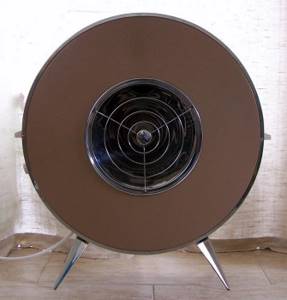
If you are faced with the question of how to heat a house in winter without gas, then you can use peat, which comes in the form of briquettes. It will cost about one and a half times more than coal.
The most common option for heating a house is to use firewood, which costs little, but it is not always convenient to use, but it will burn out much faster than coal.
For appliances installed in the house, you can use pellets; they are granules created from wood waste. You can get 1 Gcal of heat by paying 1,500 rubles. Moreover, this type of fuel is very convenient to use for boilers in which fuel can be supplied automatically.
Automation of the heating process
Even if heat loss in a building is minimized, gas for heating will be wasted if its supply to the burners is not regulated depending on external factors. These factors include the temperature of the external air environment and the temperature inside the heated premises.
Modern gas heating systems must include devices for regulating the fuel supply - boiler automation. This system includes air temperature sensors outside and inside the house. When the outside temperature changes, these devices send a signal to the control system, and the supply to the gas boiler will be increased or decreased.
How to save gas when heating a private home with gas
How to save gas in a private home?
So, how can you save gas when heating your home with gas?
The main item of energy expenditure in a private household with a gas heating boiler falls on the heating system, so special attention should be paid to saving “blue fuel” in this direction. There are several quite accessible ways to reduce gas consumption, which are presented:
There are several quite accessible ways to reduce gas consumption, which are presented:
- Insulation of private households. External walls, in this case, need to be insulated using slab materials such as mineral wool or polystyrene foam. The standard thickness of a layer of such insulation can vary between 6.0-10 cm. This insulation option allows you to save the usable area of the internal space. The basement and attic spaces must be insulated.
- Installation of energy-saving metal-plastic or wooden double-glazed windows, as well as replacing doors with more modern models that retain heat well in the room. If it is not possible to purchase new structures, high-quality insulation of old windows and doors with any heat-saving materials, including foam rubber and mineral wool, is allowed.
- Regulating the ventilation mode. Maximum efficiency is achieved by fully opening the windows for a few minutes, rather than a prolonged supply of outside air through a slightly open window. At the same time, there is a significant renewal of indoor air with minimal losses of thermal energy.
- Insulation of a heating boiler, boiler or expansion tank located in unheated or poorly heated rooms.
Experts also recommend installing a programmer that allows you to reduce power levels and, accordingly, gas consumption in the absence of residents in the room.
Very high efficiency is shown by supplementing the standard gas heating system of a private house with wood fireplaces or solid fuel stoves, which make it possible to provide the room with a comfortable temperature regime with minimal fuel consumption.
Saving gas in a private home for heating
An increased temperature regime in a house relative to street indicators is possible only if there is a noticeable difference between the amount of thermal energy produced by the heating system and the total volume of heat losses.
To significantly reduce the cost of paying for gas heating and hot water, you can use various methods, including automation of the operating heating equipment and regulation of the operating mode of the ventilation system.
Savings through ventilation
High-quality ventilation, when properly arranged, helps maintain optimal temperature in the room.
When installing exhaust ventilation pipes in houses heated by gas equipment, the following basic rules must be observed.
Namely:
- the pipe is installed in a certain position;
- the pipe height indicators should not allow carbon monoxide to enter the room, both through windows and doors during ventilation;
- a special device installed to protect ventilation from dirt and precipitation should not interfere with the full outflow of combustion products.
The size and shape of the ventilation device varies. The chimney pipe can be fixed to floor and wall equipment. The dimensions of the pipe must be determined in accordance with the power ratings of the heating equipment and the diameter of the outlet pipeline opening.
The pipe for the influx of street air masses must have a sufficiently wide hole, the diameter of which always depends on the power level of the gas equipment and is approximately 0.8 cm2 for every 1 kW.
Conclusion
Savings of “blue fuel” with proper arrangement of gas heating and hot water supply systems often reaches 20-25%.
For this purpose, experts recommend purchasing convenient room thermostats with a programmer function or the most modern weather-dependent sensors, as well as using economical alternative additional sources of heat energy generation.
Analysis of heat losses and ways to reduce them
In a private house, the greatest amount of heat is lost through windows, walls and roof. In addition, a certain amount of thermal energy is lost with the escaping air through the ventilation system, because warm air is replaced by cold outside air. Therefore, the following ways to save on heating are:
Firstly, insulating the roof or attic - using stone wool, foamed polymers, covering the roof with sandwich panels. In each specific case, the choice is made based on the characteristics of building structures and the solvency of the owner.
Secondly, reducing heat loss through windows. There are two acceptable methods here. The first is to reduce the total window area of the entire house, but at the same time reducing the amount of sunlight entering the premises. The second way is to install windows with better energy performance. These are windows with double and triple glazing, multi-circuit window systems and special windows, the glass of which is coated on one side with a thin layer that reflects infrared radiation.
Thirdly, insulating the walls of the house or constructing them from materials with better thermal characteristics.
Ways to save gas in the kitchen
Plan based on your needs
It’s clear that a spacious kitchen is the dream of any housewife. However, think about whether you really need a built-in gas oven or grill that will be turned on several times a year? The fewer “bells and whistles” you have, the less consumption, and not only of gas, but also of your time to care for all this goodness. A compact but functional kitchen is the first step to saving gas.
Kettle or thermopot, what to choose
Keep burners clean
Clean burners regularly to remove grease and soot. The cleaner they are, the less gas will be required to achieve the required temperature.
Pay attention to the color of the flame, it should be blue. If red or orange “notes” appear, it’s time to clean the burners
If the color has not changed, it means that you are being supplied with low-quality gas, poorly purified from impurities.
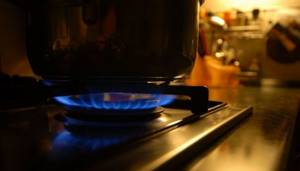
Use quality cookware
Listen to your wife and finally buy normal pots and pans. Perhaps she wants new ones for purely aesthetic reasons, but this is one of the ways to save gas at home. The material of the cookware and its thermal conductivity play a significant role in the increased consumption.
Choose pots by size
Before you and your happy wife go shopping for new pans, measure the diameter of the burners. The same principle applies here as when using an electric stove economically. The cookware should be the same size, or slightly larger than the burners. If it is less, a significant part of the gas does not fall to the bottom, but “licks” the sides, leading to senseless overspending
It is also important that the bottom of the pans is perfectly flat.
Make your pots sparkle
Clean pots can not only please the eye, but also save gas. Their shiny surface conducts heat better than one contaminated with soot.
Do you need a dishwasher in your home?
Use lids
A simple way to save gas is to cover your cookware with a lid as often as possible while cooking. Firstly, this measure will allow the dish to heat up faster, using less energy. Secondly, minimizing the access of oxygen gives food an additional, richer taste. For the same reasons, you should not pour in excess water.
Buy a pressure cooker

Modern pressure cookers bear little resemblance to the monsters we first saw 20-30 years ago. Today it is a high-tech device that looks not much different from an ordinary saucepan. But to prepare the same dish, it consumes almost half as much gas. An additional bonus is saving time and minimal loss of beneficial properties of food.
Follow the flame
It is a well-known fact that the maximum temperature is reached at the very tip of the flame. Therefore, opening the gas “all the way” is justified only when using pots with a large diameter, and even then not always. Try to adjust the flame immediately after turning on the stove so that it “rests” at the bottom with its top, and not the middle. After the water boils and as the food cooks, keep the flame at the required minimum.
Cook in large batches
Preparing meals for several days at once is an easy way to save gas and time. After all, heating food requires significantly less energy than cooking it.
Close the oven tightly
If you have a gas oven, make sure that its door closes tightly and does not let out heat. This will save you from pointless expenses.
As you can see, saving gas at home is not such a difficult task. Using these simple tips, you can reduce your consumption by 15-20%.
Saving energy at home
Electricity is an irreplaceable resource and one of the most expensive. Often we simply do not notice that we are wasting watts and kilowatts without much need. If you identify and eliminate “bad habits” in using electricity at home, you can reduce its consumption by a third.
How to save on lighting
We spend a significant portion of electricity on lighting rooms. To reduce electricity consumption, just follow a few rules:
- Turn off the lights every time you leave a room or office area. Forgetting about the switch? Buy motion sensors that turn off the lights for you;
- local lighting is much more effective than a classic chandelier in the middle of the ceiling. Install floor lamps, sconces or table lamps. They save energy and disperse darkness into corners;
- use energy saving lamps. The volume of electricity consumption when installing LED bulbs is reduced by 70 - 90%. They last longer and are resistant to voltage surges;
Saving energy when using appliances
The coefficient of useful energy consumption when operating household appliances is not as high as we think. Electricity consumption can be reduced right now without significant changes in habits and personal routine.
- Unplug all appliances that you are not using. Turn off the “charging” immediately after the signal about full recharge. This also includes electric drying in the background, etc.;
- Defrost your refrigerator regularly. Make sure the insulation is tight and the refrigerator has adequate ventilation.
- An electric stove significantly increases electricity consumption. To reduce electricity consumption, use dishes with a thin bottom and heat the water in an electric kettle. Turn off the stove a little earlier than the cooking process is completely completed;
- wash with a full load of the washing machine, but do not overload it (electricity consumption will increase by 10%). If you have a two-phase meter, use the delayed start mode and wash at night: the payment coefficient for the night tariff is lower;
- Avoid running the TV, computer or music systems in the background. This mode will require an additional 20 kW/hour from the TV, and 30 kW/hour for the computer. Your home may become unusually quiet, but energy consumption will be reduced and noise pollution will be reduced, which will allow you not only to save money, but also to have a quality rest. Eliminating standby mode will save over 200 kW per year;
- Boil only the required volume of water in the electric kettle and clean the heating coil as it gets dirty;
- The energy saving mode of the boiler will allow you to maintain the minimum temperature required in your home. Turning the boiler on again each time means wasting more electricity.
Checking indoor wiring
How to save energy if the wiring is faulty? It is problems with wiring that cause electricity leakage to nowhere. Moreover, the danger of a short circuit can not only damage the devices, but also lead to a fire. Check wiring regularly, install adapters, and do not use sparking sockets.
Installation of a two-tariff meter
Electricity consumption will be reduced by up to 50% if you zone its consumption by time of day. A two-tariff meter will help with this - a device for saving electricity.
Electricity costs more during peak hours (day and evening), while at night electrical appliances are used less, the load on the electrical network is lower, and along with it the payment coefficient decreases: from midnight to morning, a two-phase meter will allow you to save so much that it pays for itself in just a year.
Audit of the electricity meter and hidden sources of electricity consumption
Many people blindly trust the meter readings. However, it can generate additional kilowatts due to problems. Be sure to check: write down the meter readings, turn off all electrical appliances in the house and check after an hour whether the meter is adding extra numbers. If so, contact your utility company to request a replacement appliance.
Before paying your electricity bill, make sure that the cost is calculated according to the energy you consume.
Secretly eating electricity can:
- rooms that do not require air conditioning (hallway, bathroom). Close windows and doors to rooms you do not want to cool or heat;
- electrical appliances connected to the network;
- a refrigerator that is constantly looked into;
- high brightness and contrast of monitors;
- scale in the water heater (because of it, electricity consumption per year will increase by 15-20%).
How to save gas
Gas meter installation
If in apartments gas is most often used for kitchen stoves and heating water in boilers, then in private houses the heating system runs on gas. First, you need to install a meter that will count how much gas you have spent, because it is better to pay for the actual cubic meters consumed. After all, despite the fact that installing a meter is not a particularly cheap undertaking, it is better to pay for the gas that you actually used than what the local gas organization calculated for you.

Moreover, installing a gas meter is also beneficial in apartments, and not just in private houses. By paying for the installation of a meter, we can be sure that we are paying for the gas consumed, and not paying for the cubic meters that Gorgaz calculates based on average consumption. This is especially true when hot water is turned off and utility companies send bills that contain the clause: “For heating water during a hot water supply outage.” Those who have an electric water heater installed are very happy about such payments; they heat the water themselves, but still have to pay more for gas than necessary.
Modernizing your home
In order not to heat the street during the cold season and spend much less gas, it is more practical to insulate the walls of the house, which will make the home both more comfortable and more energy efficient. It is better to spend money on insulation than to pay exorbitant amounts for gas every year. Insulated houses require significantly less fuel, and this allows you to save gas at home
, since in winter the rooms become warmer, and in summer living quarters do not require as much cooled air from the air conditioner and double savings are obtained - gas in winter and electricity in summer.
The heating system in a private home, which consumes most of the gas, can be modernized, which will reduce the cost of gas consumed. Install a pump on the gas boiler that will circulate the heated coolant through the system. Install thermal heads on the heating radiators, and attach foil screens between the radiator and the wall, which will reflect heat into the room and not heat the walls of the house. Try not to cover heating radiators with thick curtains, drapes, furniture and various decorative screens that prevent heat from spreading freely throughout the room.

Save money by not heating all rooms equally
Not all rooms and volumes of the house need to be maintained at the same temperature. For example, storerooms, gyms, garages, workshops may have a slightly lower temperature, while children's rooms, showers or bathrooms may have a higher temperature.
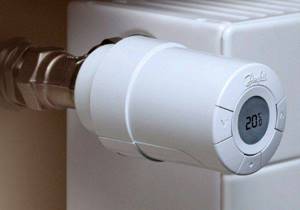
To maintain the desired temperature in a particular room, you need to install regulators on each heating radiator. The principle of their operation is simple - they change the working cross-section of the heater pipe and reduce or increase the coolant circulation rate. It is enough to set the required temperature value on the regulator. This measure optimizes the total gas consumption for heating water in the boiler.
In this article we will look at the following ways to save gas
How to save gas for heating, what equipment to use.
Thermoregulation by thermostat
Weather-dependent sensors, thermostats
More efficient equipment.
Condensing gas boilers.
Saving gas for cooking
Gas substitution
Solar energy for home
Special roof and wall coverings.
Heat pumps for heating
Heating by air conditioner
When it comes to saving gas
, the first thing that comes to mind is insulation of a house or apartment. And it is right. A warm house is not only much more economical, but also takes care of the health of its inhabitants. The absence of drafts and a comfortable temperature will protect your family members from illness, and gas savings will be maximum.
| From the author: In 2012, I insulated my house in the village of Oseshchina (Vyshgorod district, Kiev region). External insulation with 10 cm of glass wool + siding, insulation of the floor 10 cm and attic 15 cm cost me approximately 35 thousand UAH (house 8x8, 2 floors). If before insulation I spent 3800-4200 UAH annually on heating, then in the winter of 2012-13 I spent only 2200 UAH. |
You will find more information about home insulation in this article.
Method No. 2. Use of condensing boilers

This method has already been tested over decades of “successful savings” in developed countries. The operating principle of condensing boilers is based on the use of waste gases (exhaust) - condensate of water vapor from flue gases, which was previously released into the atmosphere - to obtain additional heat, so to speak, to direct it into a peaceful channel. For comparison: the temperature of the exhaust gases at the outlet of a condensing boiler is 50–60 °C, while for a conventional boiler the same temperature is 120–180 °C.
The main advantage of condensing gas boilers is significant gas savings of up to 15%! In addition, the boilers operate stably even with insufficient gas pressure in the network, have deep modulation (automatic change in boiler power) up to 20%, as well as an increased level of noise insulation.
How to save gas on the meter
The fact that you installed a gas meter will already save you money, because you will only pay for the gas you consume. But every person wants to save as much as possible on utilities so that they can then spend these savings on themselves. There are several methods on how to legally save gas using the meter:
- Be sure to turn off appliances you are not using;
- Use as much gas as needed;
- Take advantage of every opportunity to save gas;
- If you use a gas water heater, save hot water;
- Use special dishes for a gas oven.
First, you must understand that cooking gas should only heat the bottom of the cookware, not the walls. In this case, only the gas flow increases, and not the heating temperature.
There are several simple tricks to save money on your gas meter. You can place foil on the surface of the oven, this will help reflect the heat and reduce cooking time.

If possible, use special dishes for gas stoves, they have grooves on them, then the dish will be able to cook itself when the gas is turned off. A kettle with a whistle will prevent you from using gas for an extra minute.
If your home has a gas water heater, try to take a shower rather than a bath, turn off the water when washing and brushing your teeth, and install economical shower dividers. When you wash dishes, lather them first, and then turn on the rinse water.

Purposes of using gas in an apartment
Gas supply to multi-storey residential buildings is carried out through a gas pipeline installed inside the building. At the same time, natural energy can be used in every apartment. Its main purpose is:
- Heating of premises. The apartments are heated by gas boilers. Additionally, water-heated floors can be installed, which are connected to the main heating unit.
- Cooking food. For these purposes, special stoves powered by gas are installed. They are mainly equipped with an oven, but may also have 2 or more burners.
- Hot water supply. You can ensure constant access to water supply heated from natural energy using a double-circuit boiler or gas water heater.
Regular use of all equipment requires considerable gas consumption and, accordingly, money. Reducing fuel costs is possible only if it is used correctly and economically.
Comfortable temperature
First, let's decide what temperature needs to be maintained in the house to make it comfortable to live in. Experts believe that the norm is approximately 25 degrees Celsius.
In this mode, heating systems consume one hundred percent of gas. How to reduce this norm?
It is believed that we do not have many ways to save gas. One option is to lower the temperature. If you lower the bar to 17 degrees Celsius, the heating system will consume only 68 percent of gas.
The savings are significant, but the temperature is uncomfortable for living. If we take into account that a maximum temperature of 25 degrees Celsius is not needed all the time, then this fact can already be used. For example, you can reduce the temperature in the house to 17 degrees Celsius at night and during the day when no one is home
. This will allow 78 percent of gas to be consumed.
Since the heating system will be running at full power most of the time on weekends, only 81 percent of the gas will be consumed on average during the week
. Depending on gas tariffs, residents will be able to save more than a thousand rubles in a year.
Keep water hot
In addition to heating costs, blue fuel is used in a number of houses to heat hot water. The following measures will help reduce the amount of gas consumed:
- installation of a separate flow-type gas heater. It is turned on only when the hot water tap is opened, and fuel is not wasted;
- inclusion of a hot water boiler in one circuit with the heating system. With this option, the cost of heating water for domestic needs will be minimal;
- use of thermally insulated storage tanks for hot water. In such devices, heated water does not cool down for a long time, and there is no need for frequent heating;
- use of solar collectors in water supply systems.
Combining all the methods considered makes it possible to significantly, up to 25-30% or more, reduce the cost of paying for the services of gas supply organizations.
New ways to profitably heat your home
One of them is convector heating, due to oil-type heaters and radiators, the second is an innovation, infrared heating, or PLEN.
Infrequently used, but also cheap, home heating is considered: heat pumps and solar heating. Solar energy has long been used in Western countries, but in Russia this method is still difficult to take root. The fact is that solar panels are quite expensive, but if you purchase a battery and a heating tank, connected two in one, you can get an excellent alternative source of heat.
Any cheap heating of a private home has been greatly appreciated lately, since maintaining any home is becoming very expensive. However, in a private house there is an opportunity to save money, because there you will not need housing and communal services, and you will decide for yourself when to turn on the heat, when to turn it off, and in what ways to heat it in the heating pipes.
Installing a wall-mounted boiler instead of a floor-standing one

For heating a residential building with an area of up to 400 square meters. It is better to use a wall-mounted gas boiler. This will allow you to save more on gas. A wall installation can be considered a mini boiler room. It consists of structural elements:
- expansion tank;
- group responsible for security;
- circulation pump;
- electronic board.
Expensive models have additional elements:
- wireless weather-sensitive programmer;
- indirect heating boiler;
- circulation pump with frequency control.
Single-circuit mounted tanks are often equipped with a three-way valve. It is installed at the junction with an indirect heating boiler. Heat exchangers of mounted boilers are made of copper or stainless steel.
The main savings on gas can be achieved due to the stable efficiency of the boiler. Unlike floor-standing models, wall-mounted ones most often offer forced draft solutions. Forced draft provides the combustion chamber with the required amount of oxygen. With natural traction, this indicator is not always stable.
Don't release heat into the chimney
A modern smart and environmentally friendly home should take every opportunity to save heating inside its space. This property is given to the home by a heat recovery system. It works like this:
- special heat exchangers are installed in the ventilation exhaust ducts, which remove warm and humid air to the street; they communicate with the inlet ventilation pipes;
- As warm air passes outside, it warms up the cold air coming from the street. Thus, fresh air enters the house already slightly warmed up.
If we calculate how much heat is needed to heat 1 m3 of air by 1°C, we get 0.312 kcal/m3*deg. 1 m3 of gas emits about 8000 kcal during combustion. The efficiency of a gas boiler is about 90%.
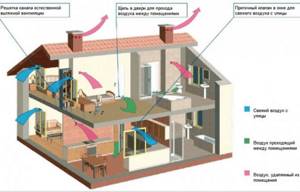
In a private house with a living area of about 100 m2, the average air exchange rate per hour should be at least 3 m3 per 1 m2 of area, that is, 300 m3 every hour. This figure will be 7200 m3 per day. Consequently, when heating the incoming air by 10°C, the savings will be 22,464 kcal or about 3 m3 of gas per day for heating.
And if we take into account that the air exchange in kitchens and boiler rooms with gas burners should be, according to SNiP 2.08.01-89* “Residential Buildings”, up to 90 m3/hour for every 1 m2, then we get a saving figure of up to 5-6 m3 of gas every day.
With the cost of blue fuel for the population on average 8 rubles per m3, the savings will be 40-50 rubles daily or up to 1200-1500 rubles monthly for heating.
Insulation and ventilation
Mineral wool, penoplex and other materials are suitable for insulating a house.
First of all, you need to take care of the insulation of your home. To do this, the outer part of the house or apartment is covered with insulating material, and old window frames are replaced with modern metal-plastic windows.
It would not be amiss to put thermal insulation on the roof if we are talking about a private household, since up to 70% of the heat “escapes” through the ceiling.
Take note: ventilate the apartment correctly - instead of ventilating for the whole day, just open the window for 15-20 minutes. This way fresh air will enter the room without losing temperature.
When arranging furniture around the room, pay attention to whether it covers the heating devices, thereby preventing the spread of heat throughout the house. Installing foil screens on the back wall of the heating radiator will also help to increase heat transfer.
